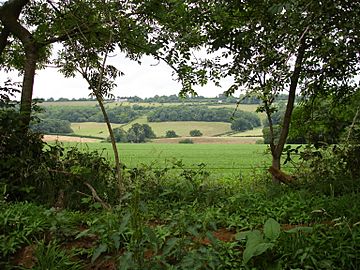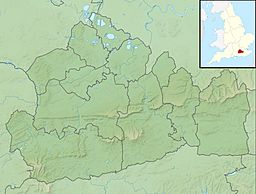Hog's Back facts for kids
Quick facts for kids Hog's Back |
|
|---|---|

The Hog's Back seen from the North Downs Way at Puttenham.
|
|
| Highest point | |
| Elevation | 154 m (505 ft) |
| Geography | |
| Parent range | North Downs |
The Hog's Back is a long, narrow hill in Surrey, England. It's part of the North Downs and stretches between the towns of Farnham in the west and Guildford in the east.
Contents
What's in a Name?
The name "Hog's Back" describes its shape. It's a narrow, stretched-out ridge, much like the back of a hog (a pig).
Even famous author Jane Austen knew it by this name. In a letter from 1813, she wrote about how much she enjoyed seeing the countryside from the "Hog's-back."
Before that, in medieval times, the ridge was called Guildown. This name was used as early as 1035. It was even mentioned when Prince Alfred of Wessex was taken captive there. Today, the name Guildown is only found in Guildown Road, a street on the side of the ridge near Guildford.
The "Guild" part of Guildown is the same as in Guildford, meaning "gold." Some people think Guildown might have been a shorter way of saying "Guildford Down," meaning "the hill by Guildford." Others believe both names come from something gold-coloured in the area, like yellow flowers or the golden sandy soil.
Where is it?
The Hog's Back rises about 154 meters (505 feet) above sea level. This makes it one of the higher hills in Surrey.
A road, the A31, runs along the top of the Hog's Back. From paths next to this road, you can see amazing views in both directions.
Looking north, you can see many towns and villages like Woking and Aldershot. On a clear day, you might even spot famous London landmarks like Canary Wharf and Wembley Arch. To the south, the view is mostly natural and beautiful. This area is protected as an Area of Outstanding Natural Beauty and a Site of Special Scientific Interest. You can see as far as Hindhead and the Devil's Punch Bowl.
The Road on the Ridge
The road along the Hog's Back is very old. Its high position was great for travelers. It kept them above the thick forests in the valleys below. This road was once part of an ancient path that went all the way from Wiltshire to the east coast of Kent.
It was also part of the main road connecting London to Winchester. Some historians think a Roman road might have followed this route too.
Today, the A31 on the Hog's Back is a dual carriageway, meaning it has two lanes going in each direction. However, the two sides of the road are separated by trees, some of which are very old. The original road was only the lanes going from Guildford to Farnham (east to west). The other two lanes, going from west to east, were added in the early 1970s.
The famous Pilgrims' Way to Canterbury also passes near the Hog's Back. However, it takes a route on the southern slopes, avoiding the busy A31.
Past Discoveries
Around the middle of the Hog's Back, some human skeletons were found in 1935. They were discovered when workers were digging for a new water pipe. One skeleton was buried face down, and another seemed to have been tied up. Experts now believe these were likely criminals who were executed and buried there over a long period of time.
This burial spot was where three different local areas (called "hundreds" in old times) met. It's thought that such places were often used for important meetings or even executions. This spot might have been known as "Seven Ditches" in old records.
Interesting Places Nearby
There are a few notable buildings and businesses around the Hog's Back:
- Hog's Back Hotel: On the north side, there used to be a mansion called Poyle Hill Lodge. It was once a semaphore station, used for sending messages with flags, because of its high position. In 1935, it became the Hog's Back Hotel, which is still a hotel and spa today.
- Greyfriars House: On the south side, this beautiful mansion was built in 1896. It's designed in the Arts and Crafts style and is now a popular place for weddings.
- Hogs Back Brewery: This independent brewery makes real ale and is located in the nearby village of Tongham, just below the Hog's Back.
- Hog's Back Cafe: This cafe is in a layby (a roadside parking area) on the A31. It's a popular stop for lorry drivers.
- Hogs Back Books: Near Guildford, the stables of an old manor called Down Place are now home to Hogs Back Books, a children's book publisher.
- Blackwell Farm: Once a model farm, Blackwell Farm is now owned by the University of Surrey. There are plans to build a new neighborhood here, which has caused some discussion.
How the Hill Was Formed
The Hog's Back is made of chalk. This chalk formed millions of years ago from the tiny skeletons of sea creatures that lived in shallow seas.
Over time, the Earth's movements folded these flat layers of chalk. At the Hog's Back, this folding was very steep, making the chalk layers stand almost upright. The chalk is much harder than the clay soils around it. Because of this, the chalk ridge has worn away slower, making it stand out as a prominent hill.
The Hog's Back is so unique that it even gave its name to a type of landform called a "Hogback." A Hogback is a long, narrow ridge with steep sides that are almost equally sloped.
Images for kids



